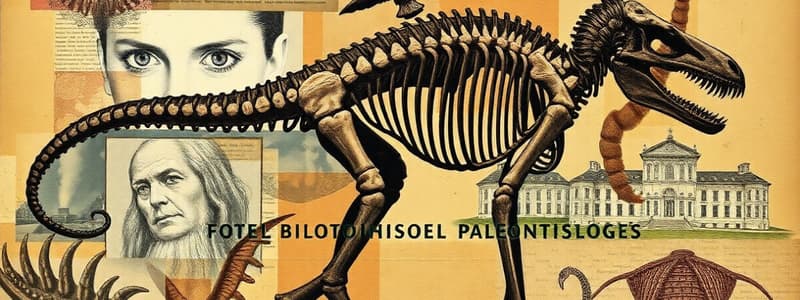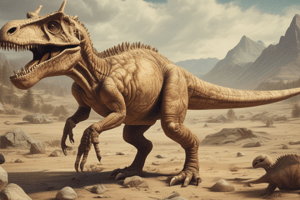Podcast
Questions and Answers
How can you study life evolution on planet Earth?
How can you study life evolution on planet Earth?
By organizing a trip to a geological museum to observe fossils.
Fossils are the remains of old living organisms that are preserved in sedimentary rocks.
Fossils are the remains of old living organisms that are preserved in sedimentary rocks.
True (A)
What are traces?
What are traces?
Traces are the remains of an old living organism that indicate its activity during its life.
Which of the following are examples of traces?
Which of the following are examples of traces?
Remains are the traces that indicate the remains of an old living organism after death.
Remains are the traces that indicate the remains of an old living organism after death.
What is the science that studies fossils?
What is the science that studies fossils?
What are the types of fossils that are classified according to their formation (or preservation)?
What are the types of fossils that are classified according to their formation (or preservation)?
A complete body fossil is a fossil that keeps the whole shape and all the details of the body of the living organism.
A complete body fossil is a fossil that keeps the whole shape and all the details of the body of the living organism.
A mammoth fossil preserved in snow is a typical example of a complete body fossil.
A mammoth fossil preserved in snow is a typical example of a complete body fossil.
Amber is a solidified resinous matter secreted by pine trees in old geologic ages.
Amber is a solidified resinous matter secreted by pine trees in old geologic ages.
What are the conditions for the formation of an amber fossil?
What are the conditions for the formation of an amber fossil?
Amber is considered as a suitable medium for the formation of complete body fossils.
Amber is considered as a suitable medium for the formation of complete body fossils.
What is a Mold fossil?
What is a Mold fossil?
What is the type of the fossil for a dinosaur's foot print?
What is the type of the fossil for a dinosaur's foot print?
Which of the following is an example of a mold fossil?
Which of the following is an example of a mold fossil?
Explain how a mold fossil forms.
Explain how a mold fossil forms.
What is a petrified fossil?
What is a petrified fossil?
Petrification is the process of conversion of the parts of old living organisms to rocky materials as a result of replacing the organic material of the organism with minerals, part by part.
Petrification is the process of conversion of the parts of old living organisms to rocky materials as a result of replacing the organic material of the organism with minerals, part by part.
Which of the following are examples of petrified fossils?
Which of the following are examples of petrified fossils?
How are petrified woods formed?
How are petrified woods formed?
Petrified woods are considered as fossils although they look like rocks.
Petrified woods are considered as fossils although they look like rocks.
What area in Qattamiya is known for its petrified forests?
What area in Qattamiya is known for its petrified forests?
Index fossils are fossils of organisms that had lived for a short period of time in the past and had a wide geographical range distribution.
Index fossils are fossils of organisms that had lived for a short period of time in the past and had a wide geographical range distribution.
Index fossils indicate the age of sedimentary rocks.
Index fossils indicate the age of sedimentary rocks.
Nummulites fossils indicate that the area was a sea floor.
Nummulites fossils indicate that the area was a sea floor.
Ferns fossils indicate a hot and rainy tropical environment.
Ferns fossils indicate a hot and rainy tropical environment.
Coral fossils indicate a clear, warm, shallow sea environment.
Coral fossils indicate a clear, warm, shallow sea environment.
The sequence of fossils in sedimentary rock layers according to their sequence of appearance is called fossil record.
The sequence of fossils in sedimentary rock layers according to their sequence of appearance is called fossil record.
What is the correct order of appearance in plant world according to the fossil record?
What is the correct order of appearance in plant world according to the fossil record?
In the animal world, which group appeared first: invertebrates or vertebrates?
In the animal world, which group appeared first: invertebrates or vertebrates?
What is the correct order of appearance of vertebrates according to the fossil record?
What is the correct order of appearance of vertebrates according to the fossil record?
Archaeopteryx fossil is considered a link between reptiles and birds.
Archaeopteryx fossil is considered a link between reptiles and birds.
What is the correct order of appearance in the animal kingdom according to fossil record?
What is the correct order of appearance in the animal kingdom according to fossil record?
When searching for petroleum, geologists take samples from the rocks of the exploratory wells.
When searching for petroleum, geologists take samples from the rocks of the exploratory wells.
What do microfossils like foraminifera and radiolaria indicate?
What do microfossils like foraminifera and radiolaria indicate?
Flashcards
What are fossils?
What are fossils?
Fossils are the preserved traces or remains of ancient organisms found in sedimentary rocks.
What is a trace fossil?
What is a trace fossil?
A trace fossil is a preserved trace of an organism's activity, like a footprint, burrow, or trail.
What is a fossil remain?
What is a fossil remain?
A fossil remain is a preserved part of an organism's body, like a bone, shell, or tooth.
What is Paleontology?
What is Paleontology?
Signup and view all the flashcards
What is a complete body fossil?
What is a complete body fossil?
Signup and view all the flashcards
How are mammoth fossils formed?
How are mammoth fossils formed?
Signup and view all the flashcards
What is Amber?
What is Amber?
Signup and view all the flashcards
How are amber fossils formed?
How are amber fossils formed?
Signup and view all the flashcards
What is a solid mold fossil?
What is a solid mold fossil?
Signup and view all the flashcards
How are solid mold fossils formed?
How are solid mold fossils formed?
Signup and view all the flashcards
What is a cast fossil?
What is a cast fossil?
Signup and view all the flashcards
How are cast fossils formed?
How are cast fossils formed?
Signup and view all the flashcards
What is a petrified fossil?
What is a petrified fossil?
Signup and view all the flashcards
How are petrified fossils formed?
How are petrified fossils formed?
Signup and view all the flashcards
What is petrification?
What is petrification?
Signup and view all the flashcards
What are index fossils?
What are index fossils?
Signup and view all the flashcards
How do index fossils help us?
How do index fossils help us?
Signup and view all the flashcards
What is a fossil record?
What is a fossil record?
Signup and view all the flashcards
What does the fossil record show us?
What does the fossil record show us?
Signup and view all the flashcards
What is Archaeopteryx?
What is Archaeopteryx?
Signup and view all the flashcards
What are the suitable conditions for fossil formation?
What are the suitable conditions for fossil formation?
Signup and view all the flashcards
Why is the presence of a hard skeleton important for fossilization?
Why is the presence of a hard skeleton important for fossilization?
Signup and view all the flashcards
Why is rapid burial important for fossilization?
Why is rapid burial important for fossilization?
Signup and view all the flashcards
Why is a suitable medium important for fossilization?
Why is a suitable medium important for fossilization?
Signup and view all the flashcards
How do fossils help us study paleoenvironment?
How do fossils help us study paleoenvironment?
Signup and view all the flashcards
How are fossils used in petroleum exploration?
How are fossils used in petroleum exploration?
Signup and view all the flashcards
Study Notes
Fossils
- Fossils are considered an exciting world, a story within sedimentary rocks. They reveal the deep past, millions of years before human existence.
- Fossils are traces and remnants of ancient living organisms preserved in sedimentary rocks.
- Traces are marks of an organism's activity during life.
- Examples of traces include worm tunnels and dinosaur footprints.
- Remains are the parts of an organism after death.
- Examples of remains include shark teeth and dinosaur skulls.
Types of Fossils
- Fossils are classified by how they formed (preserved).
- Fossil of a complete body: Preserves the complete shape and detail of a deceased organism rapidly buried (e.g., snow, amber).
- Mammoths preserved in snow are an example.
- Amber, solidified tree resin, preserved insects.
- Mold fossils: Form when an organism's hard parts are buried, the organism decays and a hollow impression is left in the surrounding rock.
- A mold is a replica of the internal details.
- Cast fossils: Form when minerals fill the hollow mold created by the decaying organism.
- An external replica of the organism.
- Petrified fossils: Minerals replace the organic material of an organism, preserving its shape.
- Petrified wood is an example. This occurs in slowly changing conditions.
Fossil Formation
- Minerals replace the organic matter of an organism.
- The organism is buried quickly and is preserved from decomposition or decaying.
- The appropriate environmental conditions are required for fossil formation.
Importance of Fossils
- Age determination of sedimentary rocks.
- Understanding paleoenvironments. This is figuring out the environment organisms lived in during the past e.g. climate.
- Studying life evolution.
- Petroleum exploration.
Fossil Record
- The order that fossils appear in sedimentary rock layers shows how organisms evolved.
- Life began in the sea and later developed on land.
- Organisms evolved from simple to complex forms.
Animal Fossils
- Invertebrates (e.g., corals, mollusks) came before vertebrates (e.g., fish).
- Fish preceded amphibians, then reptiles, and finally birds and mammals.
Index Fossils
- Organisms that lived briefly but were geographically widespread.
- Their presence in sedimentary layers indicates the approximate age of the layer.
Studying That Suits You
Use AI to generate personalized quizzes and flashcards to suit your learning preferences.




